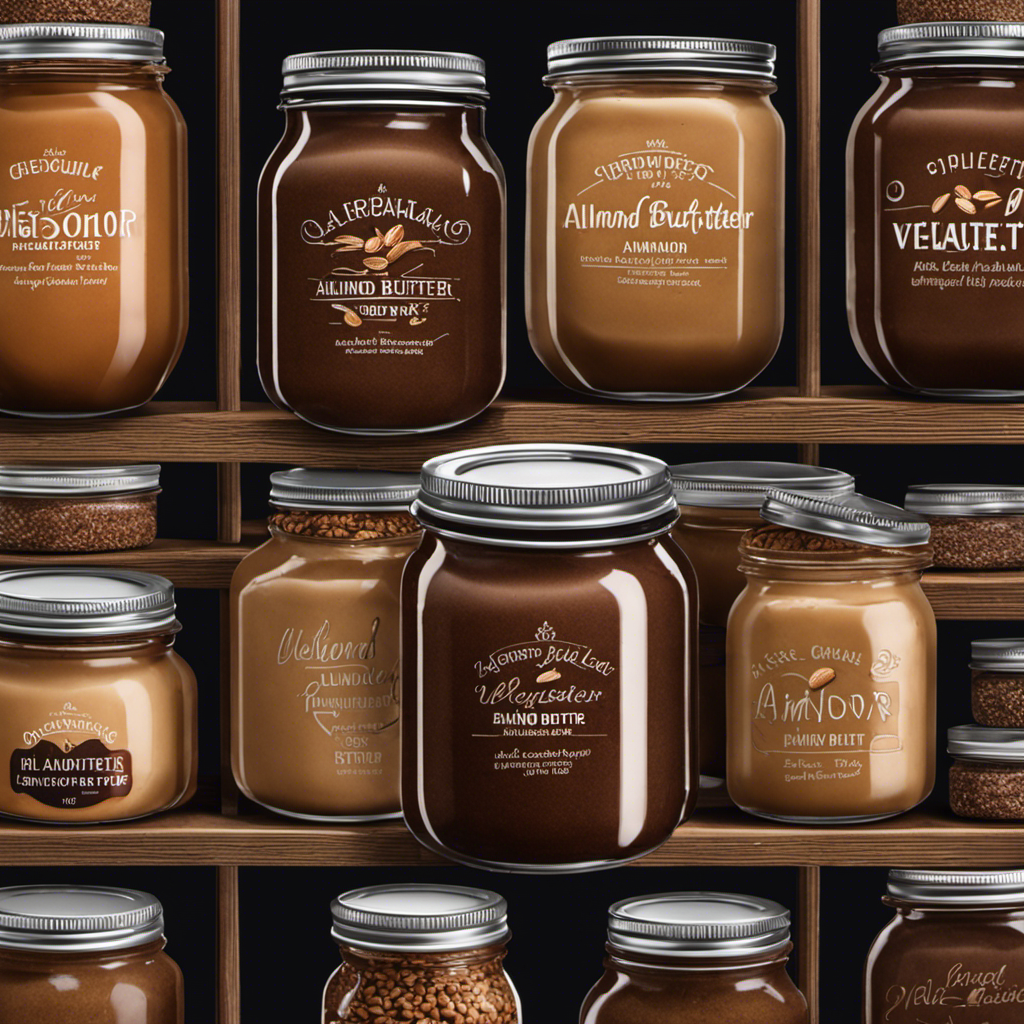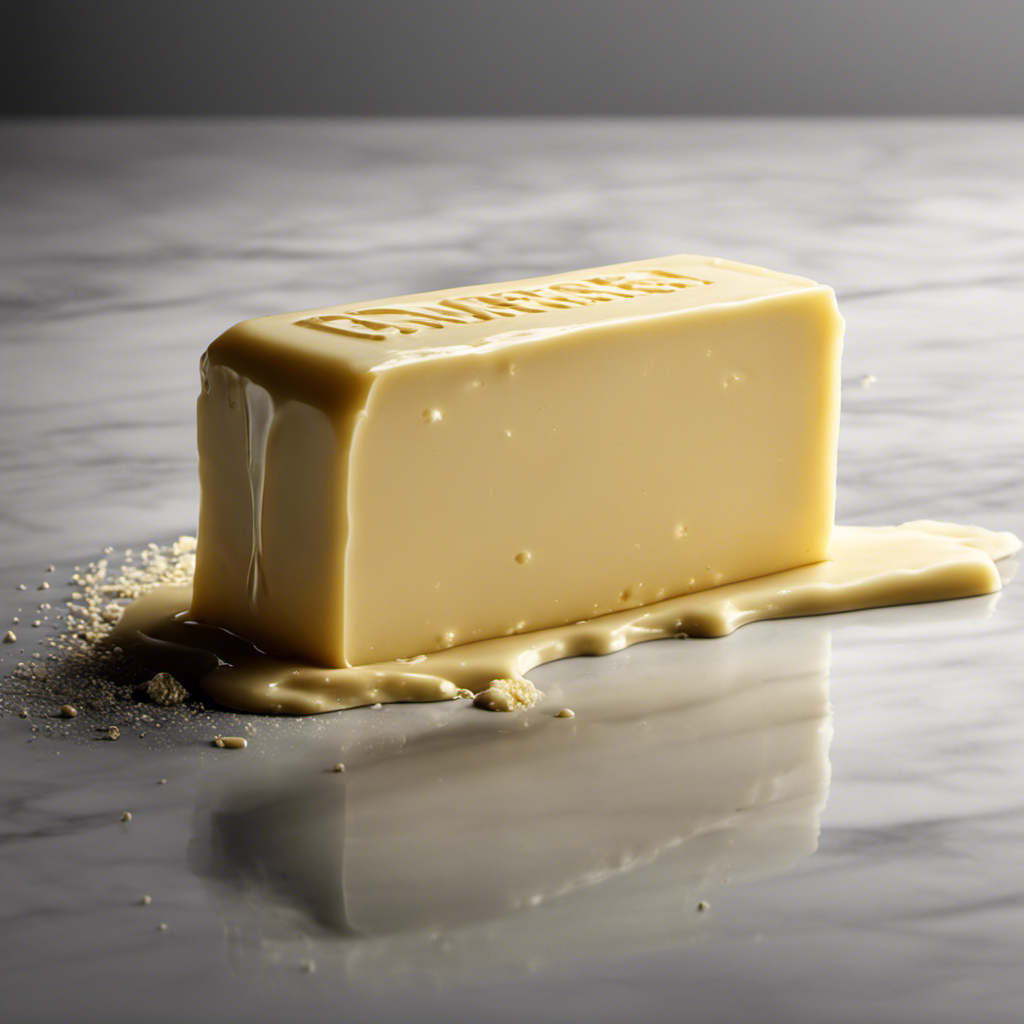A Butter Bell offers enhanced microbiological safety because it creates a sealed, water-based environment that limits exposure to airborne microbes and cross-contamination, unlike traditional fridge storage, which relies on external refrigeration and can be more vulnerable to temperature fluctuations and handling risks. Proper hygiene and container integrity are vital in both methods. To discover how each approach impacts butter’s safety and longevity, keep exploring the key factors involved.
Key Takeaways
- Butter Bells provide a sealed, water-immersion environment that reduces microbial exposure and cross-contamination risks.
- Refrigeration slows bacterial growth but requires consistent temperature and hygiene practices for safety in both methods.
- Proper cleaning and airtight packaging in the fridge prevent airborne microbes and cross-contamination.
- Butter Bells’ antibacterial coatings and sealed design naturally inhibit bacterial proliferation.
- Both methods depend on hygiene, handling, and storage conditions to ensure microbiological safety.
Understanding Microbial Growth in Butter
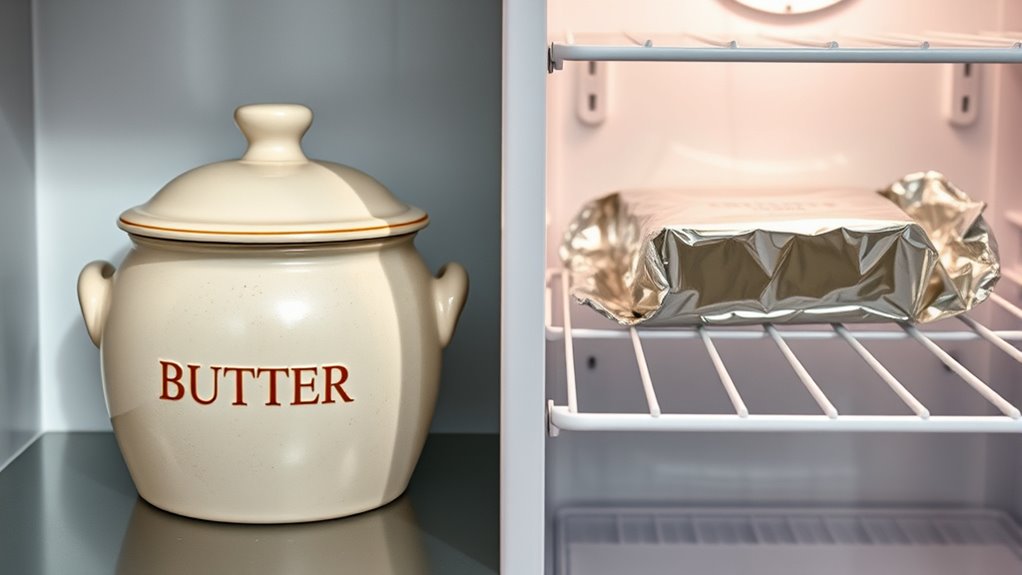
Understanding microbial growth in butter is essential because, although butter has a low moisture content that inhibits many bacteria, it can still harbor and support certain microbes under the right conditions. Artificial preservatives are often added to commercial butter to slow down microbial activity, helping to extend its shelf life. Without these preservatives, bacteria and molds can develop, leading to spoilage and potential health risks. Microbial growth also causes flavor degradation, making butter taste stale or rancid. Proper storage, whether in a butter bell or the fridge, minimizes these risks by limiting microbial activity. Additionally, temperature control plays a key role in preventing microbial proliferation, as improper temperatures can facilitate the growth of harmful microbes. Recognizing how microbes can survive and multiply in butter emphasizes the importance of good storage practices to maintain freshness and safety.
The Role of Temperature in Bacterial Development

Temperature plays a crucial role in how quickly bacteria can develop in butter. When stored at ideal temperatures, bacteria multiply rapidly, increasing the risk of spoilage and foodborne illness. However, temperature fluctuations can slow bacterial growth, causing bacteria to enter a state of dormancy. During dormancy, bacteria become inactive, preventing their proliferation even if conditions improve later. Keeping butter consistently cold, whether in a butter bell or fridge, minimizes bacterial development by limiting their active phase. Conversely, slight temperature increases can activate dormant bacteria, leading to rapid growth once conditions are favorable again. Understanding how temperature influences bacterial dormancy and activity helps you choose storage methods that reduce microbial risks and extend butter’s freshness. Regularly maintaining proper storage temperatures is essential for microbiological safety, ensuring butter remains safe to consume over time.
How a Butter Bell Maintains Safety Standards
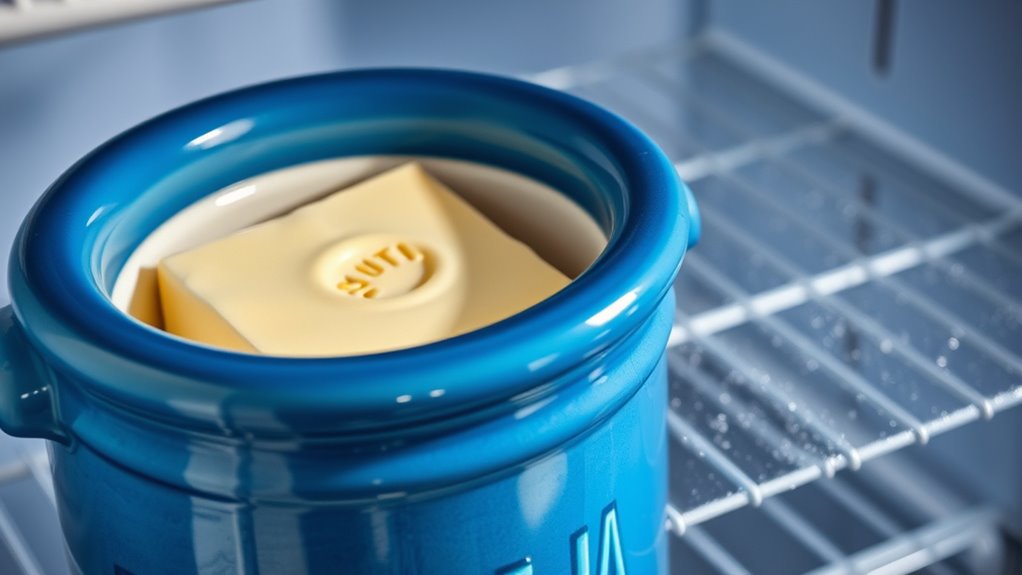
A Butter Bell keeps butter safe by creating a sealed storage environment that limits exposure to outside bacteria. This design helps suppress natural bacteria growth, reducing the risk of spoilage. As a result, your butter stays fresh and safe to use longer than it would in an open container. Additionally, the airtight seal prevents air and contaminants from entering, further enhancing microbiological safety.
Sealed Storage Environment
Because a Butter Bell keeps butter submerged in water, it creates a sealed environment that prevents air and contaminants from reaching the butter’s surface. This sealed setup minimizes microbial exposure, helping to maintain freshness and safety. Many Butter Bells feature antibacterial coatings on their surfaces, further inhibiting bacterial growth. The airtight seals ensure no external air or microbes enter, keeping the butter protected from airborne bacteria. By limiting exposure to oxygen and contaminants, the Butter Bell reduces the risk of spoilage and microbial contamination. This controlled environment is a key advantage over traditional storage methods. Overall, the combination of water immersion, antibacterial coatings, and airtight seals makes the Butter Bell a safer, microbiologically sound choice for storing butter.
Natural Bacteria Suppression
The water in a Butter Bell plays a crucial role in naturally suppressing bacteria growth. It creates a sealed, humid environment that inhibits the development of harmful microbes. This setup leverages fermentation benefits, as the limited oxygen and consistent moisture slow bacterial activity, helping keep butter fresh longer. The preservative effects of this method mean fewer preservatives are needed, reducing chemical exposure. Unlike a fridge, which relies on cold temperatures alone, a Butter Bell’s water barrier actively encourages a stable environment where bacteria struggle to thrive. By maintaining a consistent microclimate, it supports safety standards without artificial additives. This natural bacteria suppression enhances butter’s longevity and safety, making it a smart choice for those seeking a preservative-free, bacteria-resistant storage solution.
Refrigerator Storage and Its Microbiological Implications

When you store butter in the fridge, bacteria can grow if temperatures aren’t consistently maintained below 40°F. Cross-contamination from other foods can also introduce microbes that threaten safety. Staying mindful of these factors helps prevent microbiological risks and keeps your butter safer to enjoy. Additionally, understanding cookie categories can help you manage your online privacy while browsing related content.
Bacterial Growth Risks
Storing butter in the refrigerator can pose bacterial growth risks if not managed properly. While refrigeration slows bacteria, improper handling or poor packaging materials can still allow microbial contamination. Some commercial butter contains artificial preservatives that inhibit bacterial growth, but homemade or unpreserved butter is more vulnerable. If butter is left exposed or stored in damaged or porous packaging, bacteria from the environment can infiltrate and multiply. Dirty utensils or repeated handling increase contamination chances. Even low temperatures don’t eliminate all bacteria, so proper packaging and hygiene are essential. To minimize risks, ensure your butter is stored in airtight containers and avoid cross-contamination. Monitoring storage conditions helps reduce bacterial growth risks and keeps your butter safer for longer. Incorporating AI-powered data analytics can assist in tracking optimal storage environments and detecting potential microbial threats early.
Temperature Control Factors
Maintaining the right temperature in your refrigerator is crucial for controlling microbial activity on butter. When kept at the proper temperature, typically around 35-40°F (2-4°C), butter remains fresh and safe to consume. Proper refrigeration slows bacterial growth, helping preserve flavor and preventing spoilage. Consistent temperature control also maintains the butter’s aesthetic appeal by preventing melting or separation, which can affect appearance. Fluctuating temperatures may lead to undesirable changes, such as rancidity or mold development, compromising both safety and quality. By monitoring your fridge’s temperature regularly and avoiding frequent door openings, you ensure butter stays flavorful, visually appealing, and microbiologically safe for longer periods. Temperature regulation is a simple yet essential factor in preserving butter’s integrity over time. Additionally, understanding temperature control principles can help maintain other perishable foods effectively.
Cross-Contamination Potential
Cross-contamination poses a significant risk in refrigerator storage, especially when butter shares space with other foods. Poor hand hygiene or contaminated utensils can transfer bacteria from raw meats or unwashed produce to butter. This increases the chance of microbial spread, especially if butter isn’t properly protected. To emphasize the risk, consider this table:
| Risk Factor | Potential Consequence |
|---|---|
| Shared shelves | Bacterial cross-over |
| Unclean utensils | Contamination of butter |
| Poor hand hygiene | Spread of pathogens |
| Improper storage containers | Bacteria growth and transfer |
| Overfilled fridge | Limited airflow, increased contamination risk |
Stay vigilant by practicing good hand hygiene and using clean utensils to minimize cross-contamination and protect your health.
Comparing Shelf Life and Safety in Both Methods
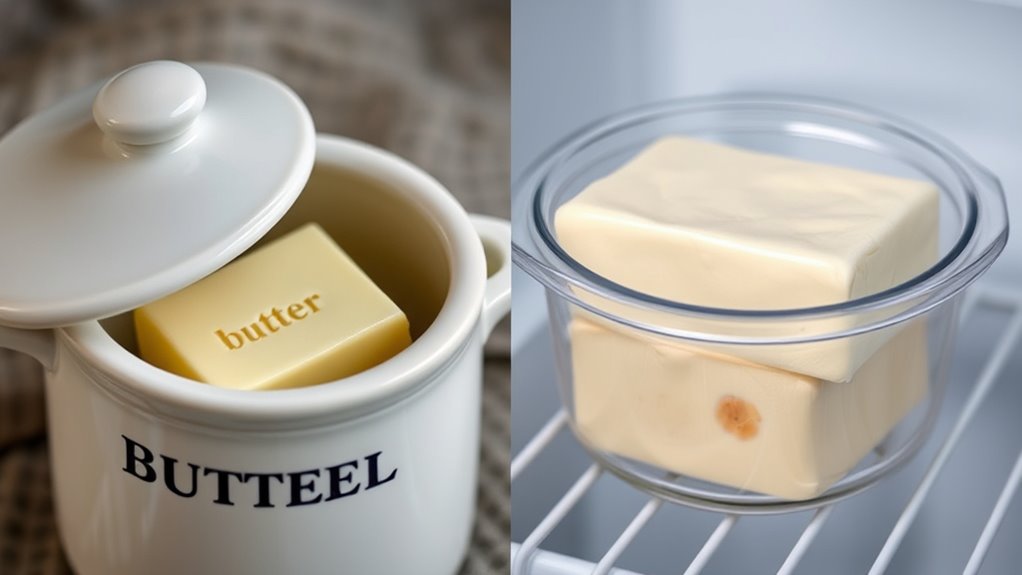
When it comes to shelf life and safety, the method you choose can considerably impact how long butter stays fresh and whether it’s safe to consume. Using a butter bell typically keeps butter at a stable temperature, slowing butter oxidation and extending freshness. Its ceramic or porcelain materials create a sealed environment that minimizes exposure to air and light, reducing spoilage risks. In contrast, storing butter in the fridge prolongs shelf life by slowing microbial growth, but exposure to fluctuating temperatures and moisture can accelerate butter oxidation, leading to rancidity. The choice of storage container materials matters—metal or plastic containers may introduce contaminants or cause chemical reactions, affecting safety. Additionally, regular maintenance and cleaning of storage containers can further reduce the risk of bacterial growth, ensuring safer storage conditions. Overall, both methods offer benefits, but understanding how container materials influence oxidation and microbial safety helps you make an informed decision.
Common Contaminants and Their Risks
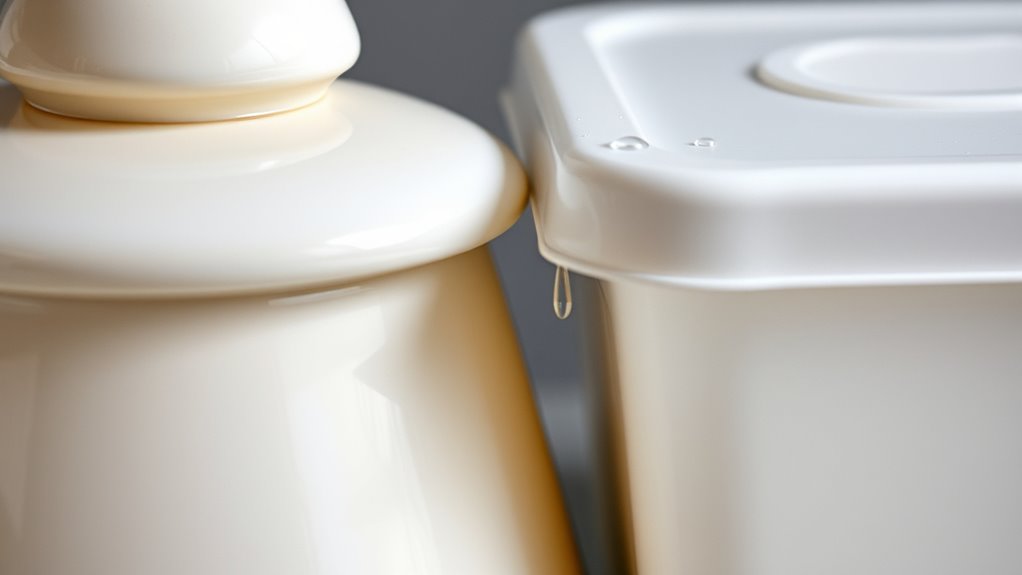
Contaminants can find their way into butter storage areas through various sources, posing health risks if not properly managed. Artisanal bacteria, often present in homemade or unpasteurized butter, can develop into harmful pathogens if conditions are favorable. These bacteria may originate from raw milk or poor hygiene during processing. Packaging integrity plays a vital role in preventing contamination; damaged or improperly sealed containers allow airborne microbes or bacteria from contact surfaces to enter. If you neglect these factors, you risk introducing contaminants that can cause foodborne illnesses. Whether storing butter in a butter bell or the fridge, maintaining good hygiene and ensuring packaging stays intact are essential steps toward safeguarding your health and preventing microbial growth. Additionally, understanding airless paint sprayers and their proper maintenance can help ensure the longevity and safety of your equipment, just as proper storage practices protect your food.
Best Practices for Safe Butter Storage

To guarantee your butter stays fresh and safe to eat, adopting proper storage practices is essential. Store butter in a cool, consistent temperature, ideally between 60-70°F, to maintain its desirable butter texture and prevent spoilage. Using a butter bell or a covered dish offers better user convenience by protecting butter from light, air, and contaminants. Keep butter away from strong-smelling foods to avoid flavor transfer. Always use clean utensils to scoop out butter, preventing bacterial growth. If storing in the fridge, wrap it tightly or use an airtight container. For longer storage, consider freezing butter, but be sure to thaw it safely before use. Awareness of narcissistic behaviors can help in recognizing and preventing contamination or spoilage caused by improper handling. Following these practices helps preserve quality, minimizes microbiological risks, and guarantee your butter remains safe and enjoyable.
Frequently Asked Questions
How Does Humidity Affect Butter’s Microbial Growth?
Humidity impact plays a significant role in microbial proliferation on butter. Higher humidity creates a moist environment, encouraging bacteria and mold growth, which can compromise safety. When humidity is low, microbial growth slows down, making butter less prone to spoilage. You should store butter in a controlled environment, ideally with moderate humidity, to reduce microbial proliferation and maintain freshness longer. Proper storage helps prevent unsafe microbial activity.
Can Butter Stored in a Butter Bell Develop Mold?
Did you know that mold spores are everywhere, with over a trillion present in the environment? If you store butter in a butter bell, mold can develop if storage hygiene isn’t maintained, especially if moisture gets trapped. To prevent mold, keep your butter dry, clean your butter bell regularly, and guarantee proper mold prevention practices. This helps you enjoy fresh, safe butter without the risk of mold growth.
Are There Specific Bacteria That Thrive in Butter Bell Storage?
You ask if certain bacteria thrive in butter bell storage. While butter bell bacteria are generally minimal, microbial growth can occur if the butter isn’t properly cleaned or exposed to contaminants. Bacteria like mold or spoilage organisms might develop, especially in warm, humid environments. To prevent this, regularly clean your butter bell and keep it in a cool, dry place. Proper hygiene helps reduce microbial growth and keeps your butter safe.
How Often Should Butter Be Replaced in a Butter Bell for Safety?
Think of your butter as a delicate bloom, needing just the right environment to stay vibrant. You should replace the butter in your butter bell every 1-2 weeks, as storage duration influences butter freshness and safety. This keeps bacteria at bay, preventing spoilage. Regularly check for any off smell or mold, and trust your senses to ensure your butter remains fresh and safe to enjoy.
Does the Type of Butter (Salted vs. Unsalted) Influence Safety?
You might wonder if the type of butter, like salted or unsalted, affects safety. Salted butter contains salt, which acts as a natural preservative, making it slightly more resistant to bacterial growth. Unsalted butter lacks this, so it’s more prone to microbial activity if not stored properly. Regardless of type, always keep butter covered and refrigerated if not used quickly to guarantee it stays safe to eat.
Conclusion
Choosing between a butter bell and the fridge is like steering through a garden maze—you want to find the safest path. By understanding how temperature affects microbial growth, you can keep your butter fresh and safe. A butter bell acts as a guardian, protecting your butter like a shield, while proper fridge storage ensures your butter stays uncontaminated. Whichever method you choose, follow best practices to keep your butter’s safety as solid as a fortress.



